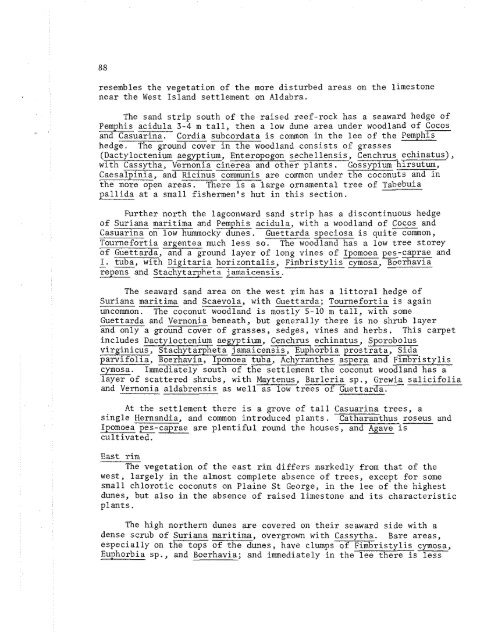ATOLL RESEARCH BULLETIN - Smithsonian Institution
ATOLL RESEARCH BULLETIN - Smithsonian Institution
ATOLL RESEARCH BULLETIN - Smithsonian Institution
You also want an ePaper? Increase the reach of your titles
YUMPU automatically turns print PDFs into web optimized ePapers that Google loves.
esembles the vegetation of the more disturbed areas on the limestone<br />
near the West Island settlement on Aldabra.<br />
The sand strip south of the raised reef-rock has a seaward hedge of<br />
Pemphis acidula 3-4 m tall, then a low dune area under woodland of Cocos<br />
and Casuarina. Cordia subcordata is common in the lee of the emp phis<br />
hedge. The ground cover in the woodland consists of grasses<br />
(Dactyloctenium - aegyptium, Enteropogon sechellensis, Cenchrus echinatus),<br />
with Cassytha, Vernonia cinerea and other plants. Gossypium hirsutum,<br />
Caesalpinia, and Ricinus communis are common under the coconuts and in<br />
the more open areas. There is a large ornamental tree of ~abebuia<br />
pallida at a small fishermen's hut in this section.<br />
-<br />
Further north the lagoonward sand strip has a discontinuous hedge<br />
of Suriana maritima and Pemphis acidula, with a woodland of Cocos and<br />
Casuarina on low hummocky dunes. Guettarda speciosa is quite common,<br />
Tournefortia argentea much less so. The woodland has a low tree storey<br />
of Guettarda, and a ground layer of long vines of Ipomoea pes-caprae and<br />
- I. - tuba, with Digitaria horizontalis, Fimbristylis cymosa,Boerhavia -<br />
repens and Stachytarpheta jamaicensis .<br />
The seaward sand area on the west rim has a littoral hedge of<br />
Suriana maritima and Scaevola, with Guettarda; Tournefortia is again<br />
uncommon. The coconut woodland is mostly 5-10 m tall, with some<br />
Guettarda and Vernonia beneath, but generally there is no shrub layer<br />
and only a ground cover of grasses, sedges, vines and herbs. This carpet<br />
includes Dactyloctenium aegyptium, Cenchrus echinatus, Sporobolus<br />
virginicus, Stachytarpheta jamaicensis, Euphorbia prostrata, Sida<br />
parvifolia, Boerhavia, Ipomoea tuba, Achyranthes aspera and Fimbristylis<br />
cymosa. Immediately south of the settlement the coconut woodland has a<br />
layer of scattered shrubs, with Maytenus, Barleria sp., Grewia salicifolia<br />
and Vernonia aldabrensis as wellastr~uettarZ'Z--<br />
At the settlement there is a grove of tall Casuarina trees, a<br />
single Hernandia, and common introduced plants. Catharanthus roseus and<br />
Ipomoea pes-caprae are plentiful round the houses, and Agave is<br />
cultivated.<br />
East rim<br />
The vegetation of the east rim differs markedly from that of the<br />
west, largely in the almost complete absence of trees, except for some<br />
small chlorotic coconuts on Plaine St George, in the lee of the highest<br />
dunes, but also in the absence of raised limestone and its characteristic<br />
plants.<br />
The high northern dunes are covered on their seaward side with a<br />
dense scrub of Suriana maritima, overgrown with Cassytha. Bare areas,<br />
especially on the tops of the dunes, have clumps of Fimbristylis cymosa,<br />
Euphorbia sp., and Boerhavia; and immediately in the lee there is less

















